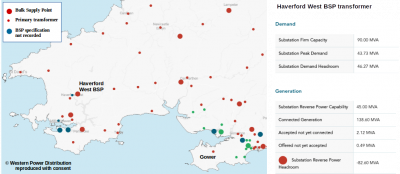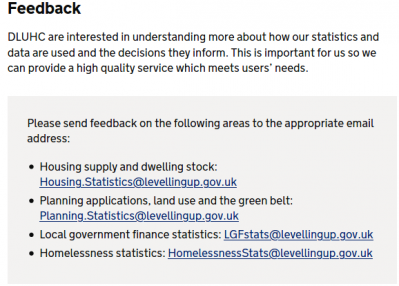@transparent, a question I’ve asked a million times. Same thing relating to tariffs. Cost of getting energy to different areas of the UK is the explanation- wonder if that’s connected to the standing charge too.
Get a copy of The Ultimate Guide to Heat Pumps
Subscribe and follow our YouTube channel!
@editor It is truly bizarre that it persists to this day. When there were local electricity boards, it was more understandable, but isn't the national infrastructure meant to be, well, national? Isn't it rather unjust for generally-richer Londoners to be paying 31p a day and South/East paying 36-40p, while the South West have to pay 49p? And still people wonder why the SW economy seems to have the handbrake on and so many young people migrate to the London area...
Posted by: @mjr@editor It is truly bizarre that it persists to this day. When there were local electricity boards, it was more understandable, but isn't the national infrastructure meant to be, well, national? Isn't it rather unjust for generally-richer Londoners to be paying 31p a day and South/East paying 36-40p, while the South West have to pay 49p? And still people wonder why the SW economy seems to have the handbrake on and so many young people migrate to the London area...
I did ask the question when I e-mailed Ofgem for an explanation, but of course received their standard reply, which did not explain the large differences. Call me an old cynic, but I wonder if the fact that their England office is at Canary Wharf has anything to do with their decision making? 😌
Posted by: @editorCost of getting energy to different areas of the UK is the explanation- wonder if that’s connected to the standing charge too.
Yes, it's always been the case that standing charges vary according to the regional DNO.
The SW and S Wales Regions, operated by Western Power Distribution, are allocated a higher rise in standing charges in order to provide an increased level of network infrastructure upgrades. WPD submit their capital expense forecasts to Ofgem for approval.
However, the tables are now turned. Those two regions are rich in renewable energy resources. Proposals to expand this sector are constrained due to the capacity limitation of transformers to accept more ‘reverse power’. The greatest infrastructure constraint is that to send that locally-generated power back from WPD’s Distribution network to the 400kV National Grid.
The ability to pass current in each direction through a transformer is not equal. Unless specifically designed to do so, the safety margin is set so that 'reverse power' is 50% of that in the 'forwards' direction.
I've shown the network capacity maps for Devon & Cornwall several times on this forum. This time I'm going to illustrate the issue with the westerly end of the South Wales region.
There is capacity around the Gower Peninsula to connect lots more renewable generation as shown by the green dots. However that's an AONB, SSSI and nature reserve. So there won't be any wind-farms and hectares of solar-panels being built there any time soon!
Look at Haverford West Bulk Supply Point transformer and you'll see a different picture. It's running at 49% of capacity in the forwards direction, but is over-subscribed by 183% in the 'Reverse Power' mode. The required level of system reinforcement for this transformer is specified at £6m.
Given the abundance of renewable energy, you would expect Devon, Cornwall and Pembrokeshire to enjoy the lowest prices in the country.
You would also expect Government funding to be directed at localised domestic energy storage strategies. This would remove the overcapacity problem at sub-stations. In turn that would quickly enable the green-energy sector to grow, whilst simultaneously combating the plight of low-wage households being pushed into Fuel Poverty.
Yet the opposite is the case. The inhabitants of regions which are energy-rich are being required to pay extra for network infrastructure upgrades to pass their renewable energy to other regions, for which they receive no benefit.
This conflicts with Government policy for Levelling-up... which Ofgem is required to implement of course.
[Levelling up] requires us to end the geographical inequality which is such a striking feature of the UK.
Source: Executive summary of Levelling Up policy paper, Feb 2022
Posted by: @derek-mI did ask the question when I e-mailed Ofgem for an explanation, but of course received their standard reply, which did not explain the large differences.
As the matter is one of Government policy, this should be directed through our MPs.
If the 'facts' concerning the rises in standing charge are placed alongside quotations from the Levelling Up policy paper, then the letter/document can be forwarded to the Sec of State for Levelling Up, Housing and Communities (DLUHC) as a "Written Question" from an MP. That process carries a lot of weight.
The Dept of Levelling Up, Housing and Communities a relatively new combination of responsibilities and they are still finding their way forward. Have a look at this snapshot from their main website section on Statistics:
This is the same Dept which is overseeing the revamp of Building Regs.
... and they're offering an open door to hear from us! 🤗
Let's politely and concisely provide them with the feedback they're seeking.
Save energy... recycle electrons!
Polly Toynbee has an article in the guardian, wanting to get rid of the standing charge - and even to go beyond that and make initial energy use free, then ramping up steeply for heavy users. There’s a petition linked to in the text, at 350k signs as I write this:
https://www.theguardian.com/commentisfree/2022/apr/21/people-struggling-pay-energy-bills-help
Thanks for that @robl It's a good move from one of the better campaigning journalists.
However, the time when variations in the standing charge principle should've been made was 2 years ago during the public consultation on the RIIO2 'contracts' issued by Ofgem. RIIO-ED2 is the agreement which covers Electricity Distribution and therefore applies to DNOs. The National Grid performance is measured against RIIO-ET2.
RIIO sets targets which the electricity and gas transporters are assessed. If they fail to meet targets for efficiency or reduction of losses, for example, then their revenue is capped - a strategy which hurts the shareholders.
The problem now is that RIIO-ED2 price controls are based on a fixed standing charge as being the DNO's income source, and it's a contract which runs until 2028.
Yes, I did file my comments at the time, and yes I did ask for the standing charge itself to be variable, not just the revenue levels permitted. (Although I had no idea that the energy crisis would later push charges so high of course)
But there are just too few members of the public who make their voices heard at these times.
One recent public consultation on the national Future Energy Strategy to attain Nett Zero by 2050 involved a 90-min live online forum for each of the DNO regions.
Only 30 participants joined in the live forum for my SW Region, the vast majority of whom worked in jobs related to the energy industry. That's not really a public consultation is it?
However... this cuts both ways.
If RHH members filed their comments during such consultations, then we'd quickly account for a high percentage of the feedback being received!
Save energy... recycle electrons!
I suspect our next fight with E.ON is about to start. Since getting switched to them, we’ve been on a direct debit of £150. This has remained unchanged throughout the winter and with the recent tariff increase that saw us go up from 22 to 33p/kWh. I got an email from them saying they’ll be taking £500 this month. That’s absolutely mental as an increase given that we’re heading into a time when we hardly use any electricity importing maybe 10-12 kWh per day.
Get a copy of The Ultimate Guide to Heat Pumps
Subscribe and follow our YouTube channel!
@batalto, a potentially terrifying prospect. We may just turn off our heating this coming winter at this rate.
Get a copy of The Ultimate Guide to Heat Pumps
Subscribe and follow our YouTube channel!
@Mars I know you have a very large property, which will have a large surface area so lots of places for heat to leak out. Would EWI (External Wall Insulation) be something that you would consider, to reduce the effect? Insulation is the cheapest long term heating there is!
ASHP/GSHP save CO2, but not money sadly at the moment. I predict that the present 4x ratio between gas and elec prices will reduce over time though.
@editor just doing some numbers and from October to April we used 3423kw off peak and 4190kw on peak.
On the new "go rates" we would be spending £256 off peak and £1423 on peak, so £1,424 for the coldest part of the year.
a 14kwh battery will allow me to "move" 2576kw across from peak to off peak - I could save roughly £682
- 26 Forums
- 2,340 Topics
- 53 K Posts
- 179 Online
- 5,998 Members
Join Us!
Podcast Picks
Latest Posts
-

RE: Latest NIBE model has known defect and no solution
@kings I’m glad I could help. NIBE are taking this very...
By Mars , 4 minutes ago
-
RE: Configuration issues with 10kW Midea R32 heat pump
@benson Hi, you are quite correct we live in a small...
By SteveT , 12 minutes ago
-
RE: Octopus Cosy Heat Pump Owners & Discussion Thread
@jamespa yes, I'm under no illusions but in some respec...
By AndrewJ , 27 minutes ago
-
RE: British Gas vs Octopus Energy vs Heat Geek vs EDF vs Aira vs OVO vs EON.Next vs Boxt
There is a thread here about Octopus Cosy heat pumps - ...
By AndrewJ , 48 minutes ago
-
RE: Poll for Time of Use, tariffs, technology
@majordennisbloodnok thanks. Unfortunately i can't upd...
By Tim441 , 4 hours ago
-

RE: The good, the bad and the not that great – my heat pump installation
It will be interesting to hear how you get on. Until re...
By cathodeRay , 4 hours ago
-

OK, so I'm going to preface this post by saying I haven...
By Majordennisbloodnok , 4 hours ago
-
RE: Electricity price predictions
It seems the end of cfd payments is in sight, even if a...
By Batpred , 6 hours ago
-
-
@pie_eater Yes, I installed Homely to a Daikin heat pum...
By gery , 18 hours ago
-

RE: Setback savings - fact or fiction?
I have now done the analysis, but not for November 2025...
By cathodeRay , 18 hours ago
-
RE: Havenwise App Help & Forum Support – Get the Most from Your Heat Pump
@davidalgarve Potentially stupid question, but are you ...
By Sheriff Fatman , 20 hours ago
-
RE: What a Bad Heat Pump Installation Looks Like
Spot on, for relatively little money, an air of ready "...
By Batpred , 21 hours ago
-
RE: Replacing my 18 month old Hitachi Yutaki ASHP
@trebor12345 Ok that makes more sense and leads is i...
By JamesPa , 1 day ago
-
-

RE: Home energy storage & battery register
Now the proud owner of: 4.1Kw peak Aiko Neostar solar...
By TechnoGeek , 2 days ago
-
-
RE: Aira Heat Pump: Stylish Scandinavian Heating
Aira called me back today, but not sure we got to the a...
By ChandyKris , 2 days ago
-
RE: Experience with Mitsu Par 50/60 Wireless Controller
The 27°C request doesn't boost the weather compensation...
By Sheriff Fatman , 4 days ago








